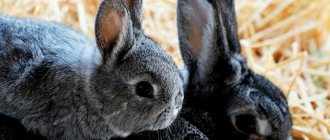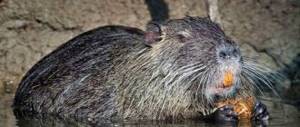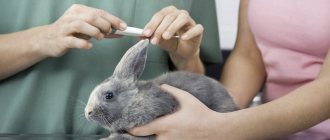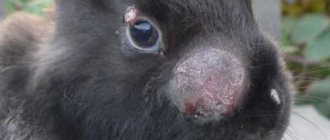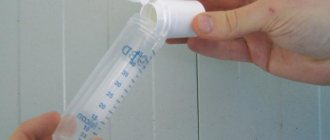Description
The activity of the virus affects almost all internal organs of the animal and is accompanied by bleeding and hemorrhages.
Particularly affected are:
- liver (necrotizing hepatitis);
- lungs (hemorrhagic pneumonia).
You can find, in addition to the usual name of the disease - VGB, the two options above in brackets. Most often, young animals aged 1.5 months or older suffer. The danger to humans and warm-blooded animals of other species has not been established today. The incubation of this infection is short and ranges from several hours to several days, depending on the ability of the animal’s immune system to resist the virus.
The disease can occur in several forms:
- lightning fast;
- acute
- subacute form
The virus is extremely contagious and tenacious. And in the vast majority of cases, his attack ends in the death of the pet. At the autopsy, massive hemorrhages are visible in almost all the internal organs of the rabbit. An outwardly healthy rabbit can die in just 2 days (with the fulminant form).
The disease is accompanied by:
- disturbance of homeostasis, intravascular coagulation;
- severe internal bleeding;
- drainage of blood from the mouth, nose, anus, uterus.
The death of a rabbit is most often caused by acute respiratory failure (pulmonary edema). Surviving rabbits become virus carriers and actively release the pathogen into the environment (at least for several, about 3, months). They themselves acquire lasting immunity to the virus.
Dangerous bacterial and parasitic infections
Another reason why rabbits die is infection with pathogenic bacteria and protozoa. Factors that influence morbidity:
- poor living conditions;
- sudden change in diet;
- crowded keeping of rodents;
- stress – transportation, noise.
Pasteurellosis
The causative agent is the Pasteurella bacterium, which, upon penetration into the body, increases vascular permeability and contributes to the development of hemorrhagic septicemia. About 75% of the population dies from this disease. Rodents at any age become infected with pasteurellosis, with the exception of young animals that have not yet been weaned from their mother. Baby rabbits are less likely to die because they receive antibodies through their milk.
Signs of pasteurellosis begin to appear a few days after infection. In the acute form, rabbits die within two days. First, their temperature rises, weakness appears, and appetite disappears. Breathing becomes heavy and frequent, mucus flows from the nose. Then severe diarrhea begins. Rodents die in severe pain.
The chronic form is characterized by the appearance of edema and abscesses on the body of rabbits, the development of conjunctivitis, pneumonia and diarrhea. To treat pasteurellosis, antibiotics and sulfonamide drugs are used in the form of injections:
- Levomycetin;
- Oxytetracycline;
- Norsulfazole;
- Sulfadimezin.
Attention! Pasteurellosis is treatable; the main thing is to start treating the rodent at an early stage. Otherwise, the rabbits will begin to die one by one.
Tularemia
The causative agent is the gram-negative bacterium tularensis. Pathogens are brought to the farm by wild animals and birds - rats, mice, raccoons, crows, magpies, sparrows. Flies, ticks, and fleas can also be carriers of the disease. After entering the rodent's body, the bacteria affect the lymphatic system and internal organs - liver, spleen, lungs.
Rabbits don't die right away. First, their lymph nodes become enlarged, from which pus later begins to protrude directly through the skin. The rodent develops a fever, develops a cough and runny nose, then diarrhea begins. The rabbit is losing weight quickly. The disease can last from 5 to 30 days, but then in most cases the rodents die.
Once the diagnosis is confirmed, all rabbits on the farm are destroyed along with their skins. Remains of feed, bedding and droppings are burned. Rabbit cages are disinfected.
Attention! Tularemia is dangerous to humans, so farm workers must observe personal hygiene rules.
Coccidiosis
Coccidiosis is caused by the simplest unicellular microorganisms – coccidia. Small rabbits aged 2-4 months are most susceptible to this disease. Parasites can infect the intestines or liver of rodents. In the first case, rabbits become weak and have bloody diarrhea. They refuse to eat, so exhaustion quickly sets in. The appearance of a convulsive syndrome indicates that the animal is dying. Death occurs from dehydration and intoxication.
If the liver is damaged, the chances of survival increase. The symptoms of the disease in this case manifest themselves differently. A sick rabbit's mucous membranes turn yellow, its appetite disappears, and its fur looks sloppy.
Drugs used for treatment:
- Sulfadimethoxine;
- Baycox;
- Metronidazole.
Signs of VGBK
Subacute and acute course is characterized by animal apathy, signs of severe anemia and respiratory dysfunction:
- cyanosis of visible mucous membranes;
- swelling of the eyelids;
- heavy and noisy breathing;
- tachycardia.
The animal's body temperature rises significantly. The rabbit takes a forced position: with a curved back and tense legs. He develops bloody diarrhea.
The acute course ends with 100% death of the rabbit.
It is characterized by:
- high body temperature (up to 41°C);
- convulsive attacks;
- throwing back the head;
- complete lack of desire to eat;
- apathy.
Literally on the second day, the pet begins to have anal bleeding, in rabbits it is uterine, and serous discharge with a large amount of blood appears from the nose and mouth. The rabbit dies.
Why do rabbits die? Rabbit diseases and their treatment
Most often, the death of a rabbit occurs from various kinds of diseases, the cause of which is the owners’ failure to comply with basic sanitary and hygienic standards.
Irregular cleaning of cages, dirty or stale water in drinking bowls, spoiled feed are the main causes of animal diseases. Poor maintenance and improper feeding means killing your own pets. In addition, if the diet is unbalanced, it does not contain enough vitamins and minerals, the rabbits’ immune system begins to malfunction, and therefore their level of resistance to viral infections decreases.
To be fair, it should be said that rabbits die not only from careless ones, but also from attentive owners who provide complete, balanced nutrition, as well as cleanliness in the cages. Such incidents are most often caused by viral and infectious diseases, the carriers of which are blood-sucking insects and sick animals.
This is especially true in the summer.
The most common diseases of rabbits are listed below:
- rabbit viral hemorrhagic disease (RVHD);
- coccidiosis;
- pasteurellosis;
- myxomatosis;
- flatulence.
VGBK
If an animal is affected by this disease, it may die. Rabbits that are more than two months old get sick. VGBK (otherwise known as fever) is extremely contagious. It can be transmitted through meat, wool and excrement of infected animals, as well as through airborne droplets.
Mortality rate is 90 percent. A particular danger is that VGB often occurs without obvious external manifestations.
In the acute course of this disease in rabbits, the symptoms are as follows: the animal completely loses its appetite, loses weight, begins to behave very restlessly, quickly becomes weak and becomes inactive, with cramps in the limbs and throwing back of the head.
More on the topic: Symptoms and treatment of mastitis in rabbits
The animal is in pain, which is why it periodically squeaks, and in some cases blood appears from the nose. The death of a rabbit occurs quickly, within one to three days. VHD destroys the liver and causes pulmonary edema, which most often causes death due to oxygen deprivation.
There is no cure for this disease in animals.
The main measure to combat VGBV is vaccination.
The first time it should be done at the age of one and a half months. Adult animals can be vaccinated at any time, but at least twice a year. There is no cure for this disease yet, and the reasons for the 10 percent recovery are unknown.
Coccidiosis
Pathogens are the simplest unicellular parasitic microorganisms. The intestines and liver are affected. It is worth saying that almost all rabbits are carriers of coccidiosis, but the clinical form of the disease is rare.
Coccidiosis has pronounced symptoms that allow this diagnosis to be made. These include: bloated stomach, sudden weight loss, lack of appetite.
The disease is transmitted through food and water through coccidia oocytes. Healthy rabbits that have good immunity usually successfully resist the development of coccidia into a painful form.
A killed rabbit affected by this disease has light-colored pinpoint nodular growths in the intestines and on the surface of the liver. Another sign of coccidiosis is an enlargement of the liver five times.
This disease can be treated with antibiotics, but to prevent it it is better to pay more attention to the conditions of detention.
Keeping cages clean and dry, as well as avoiding overcrowding, will help prevent disease.
Pasteurellosis
This dangerous infection can lead to the death of livestock in just two days.
Visible symptoms include sneezing, runny nose and refusal to eat.
This disease (unlike others) has been known for a long time.
Pasteurellosis causes death in animals, but to a much lesser extent than VGBV and myxomatosis.
Mortality rates range from 15 to 75 percent.
This depends on compliance with sanitary and hygienic standards and diet. The better they are, the greater the survival rate.
The disease occurs either in chronic or acute form.
The acute course of this disease in rabbits is characterized by an increase in the rabbit's body temperature to 41 degrees, followed by shortness of breath, sneezing and runny nose. The acute form most often leads to the death of the animal within a few days, and sometimes even hours. The chronic form usually manifests itself as rhinitis and conjunctivitis, which is often misleading when making an accurate diagnosis. The stool of the affected rabbit is liquid; in some cases, purulent abscesses appear under the skin, which open after one and a half to two months.
Pasteurellosis can be successfully treated with medication.
Myxomatosis (distemper)
This disease is a real scourge of rabbit breeders. Its carriers are blood-sucking insects (mosquitoes). External signs include copious mucous discharge from the nose and eyes, as well as bumps all over the rabbit’s body.
Of particular danger is the long incubation period (from five days to two weeks), during which there may be no external signs, and the sick animal infects healthy relatives.
More on the topic: Features of keeping rabbits in winter
In addition to mucous discharge, rabbits affected by myxomatosis have swollen eyes, and nodular tumors appear in the ears and nose.
After the first symptoms appear, the disease develops rapidly. With the edematous form, adult rabbits die within ten to fourteen days, and young rabbits die within a week.
Myxomatosis is characterized by rapid spread, and if one sick rabbit is found, then most likely the rest of the population is also infected.
There is no effective treatment for the edematous form of the disease. The nodular form is treated in 50 percent of cases with antibiotics and immunostimulating drugs. To prevent this dangerous infection, vaccination is used.
Typically, an associated VGBV vaccine is vaccinated, the structure of which contains microparticles of both viruses (VGBV and myxomatosis).
A dead rabbit that has died from myxomatosis is not suitable for food.
Flatulence
Often, intestinal bloating, called flatulence, leads to the death of animals.
The rabbit's intestine is a very sensitive organ, and if its normal functioning is disrupted, it is difficult, and sometimes simply impossible, to normalize its functioning. The cause of flatulence is a sharp change in the flora of the gastrointestinal tract. This may be caused by unusual food, which was immediately given in large quantities. This is especially true for very wet or succulent types of feed.
If a rabbit gets sick, the first external manifestations of flatulence are the animal's apathetic behavior, the rabbit suffers from colic, it loses its appetite, and may lose a lot of weight.
This is caused by fermentation processes in the intestines of undigested food, which, due to refusal to eat, is not replaced with new food. Such an environment is very favorable for the development of pathogenic bacteria, which destroy the walls of the rabbit intestines and, ultimately, can cause death.
Diagnosis, treatment, prevention
VGBV is diagnosed based on clinical symptoms and analysis of the epidemiological situation in the area.
If equipment is available, the PCR method can be used. Posthumous diagnosis is made based on the characteristic pattern of organ damage and virological studies.
Treatment methods have not been developed. To save the lives of healthy rabbits, they are given a special vaccine. It is effective only in the earliest stages of the disease.
Prevention of the disease is considered:
- compliance with animal hygiene measures;
- regular disinfection of places where animals are kept;
- vaccination.
Several vaccine options have been developed. The first vaccination can be given to a baby rabbit at 1.5 months. To create immunity in newborn animals, pregnant rabbits are vaccinated, and at any stage of gestation. In this case, newborn babies will remain immune to the disease for 1 to 2 months.
Methods for preventing VGBV
VGBV and loss of livestock can be avoided only with regular vaccination and compliance with the rules for keeping animals.
There are several types of tissue inactivated vaccine effective against viral hemorrhagic disease of rabbits. The first injection of the vaccine against VGBV is carried out at 45 days of age, then the rabbits are vaccinated three months later. Already three days after the first receipt of the vaccine, rabbits have strong immunity. Further vaccinations take place throughout life at intervals of six months.
Females expecting offspring are vaccinated at any stage of pregnancy. In this case, the litter born from a vaccinated rabbit receives complete immunity from hemorrhagic disease for a period of 30 to 60 days.
Passive immunization of rabbit livestock using serum against VGBV will help provide a preventive effect and give the animal immunity for a period of thirty days.
Comments:
Expand comments
